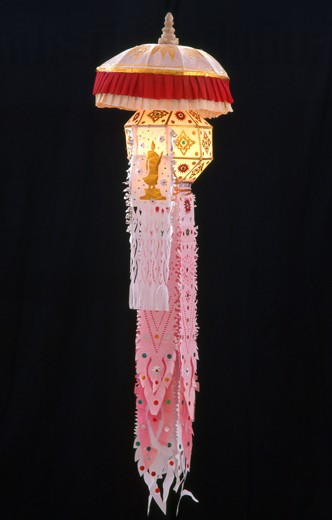Features on Asian Art, Culture, History & Travel
Archives
Archives > THAILAND > Golden Lanterns Of Chiang Mai

Golden Lanterns Of Chiang Mai
Celebrating The Age-Old Yee Peng Festival of Northern Thailand
SEE RELATED IMAGES @ PICTURES FROM HISTORY
Yee Peng is a northern Thai term signifying the full moon of the twelfth month of the lunar calendar. In Chiang Mai, Yee Peng is celebrated as a religious holiday. Throughout the region temples are full as people make merit, whilst monks give special sermons and recite religious texts. Traditionally, scrolls illustrating these texts were hung outside the temples to help explain the monks' readings, and in some small villages of the north this custom is still followed. Elsewhere candles are lit in front of every home, and in Chiang Mai ceremonial gates are constructed of palm leaves and hung with special paper lanterns.
Lanterns such as these—known as khom, and traditionally made of saa (mulberry) paper—have long played a central role in the festivities of the Khon Muang. The custom of lighting lanterns to celebrate the full moon is thought to predate that of floating krathongs, and in recent times successful attempts have been made to encourage the tradition, culminating in the Yee Peng Lantern Parade which precedes Loy Krathong by one day in the northern capital.
Coinciding with this event, and in indication of a current resurgence of pride and interest in Lanna culture, an exhibition of suwanna khom kam—literally "lanterns of gold"—was staged recently at Chiang Mai's Chiang Inn Plaza. According to the exhibitors, lanterns have been used in a variety of Thai ceremonies for many years. Originally deriving from Brahmin rituals, they were first introduced to Buddhist festivals in Bangkok during the reign of King Chulalongkorn (Rama V). Before this time lanterns were lit at the royal palace and in the houses of noblemen, employing different styles and forms to indicate the rank of the owner of the residence.
Nowadays lanterns are made and offered to monks in the hope that the merit-maker will receive wisdom in return. The flame in the lantern is said to symbolise knowledge, and the light it gives will, it is believed, guide the one who makes the offering to follow the right path in this life.
In traditional Lanna culture four types of lantern are identifiable. First is the khom teu, or "portable lantern", carried by people on split bamboo sticks during the Yee Peng festivities. After the procession, these lanterns are displayed about the chapels and ordination halls of local Buddhist temples. Secondly there are khom kwaen, or "hanging lanterns". These are hung before images of the Buddha and come in many forms—for example in the likeness of a monk's bowl, or a star, or a basket.
A third variant is the khom pat, or "fan lantern". This is a complicated revolving lantern comprising two concentric cylinders of saa paper. Whilst the outer layer of saa paper is plain, the inner layer is decorated with figures, religious symbols and patterns. A lamp lit within the inner cylinder causes shadow images to fall on the outer cylinder, whilst heat rising from the lamp turns a saa paper fan above the inner cylinder, causing it to revolve. As a result, the shadow images cast on the outer cylinder move in a manner reminiscent of shadow puppets.
Finally, and perhaps most spectacular of all, are the khom loy or "floating lanterns". These are large, balloon-like lanterns made from a lightweight bamboo frame covered with saa paper. The lantern is "floated" by means of hot air caused by a flaming torch fixed within the frame. Khom loy are released at temples and, sometimes, from private homes in the belief that misfortune flies away with the lantern. These giant "floating lanterns" are generally filled with exploding crackers and other fireworks which are ignited by slow fuse (often an incense stick) when the lantern is airborne. The results are both noisy and spectacular—particularly at night, when long strings of khom loy rise slowly from temple grounds and the premises of large hotels. Offerings of money are generally attached to the lantern, and by tradition this belongs to the first person to retrieve a fallen khom loy.
In former times khom loy were sometimes used in warfare, both to frighten opponents and in an attempt to set fire to enemy lines. In such cases the lantern balloon was released when the wind was favourable and allowed to drift over enemy positions. Here—if the timing was right—a charge of gunpowder was exploded by slow-burning incense sticks, and the lantern descended as a flaming torch.
Today the military uses of khom loy may have become redundant, but the large floating lanterns, which remain extremely popular with the people of the north, can still sometimes cause a threat of a different kind. At Yee Peng a few years back pilots approaching Chiang Mai International Airport were warned by air traffic control of an unusual hazard. A concentration of more than a thousand floating lanterns, each more than a metre square and powered by a flaming torch, had gathered over the airport at heights of up to 3,000 metres “due to a strong wind from China”. In consequence all commercial air traffic at the airport was warned to exercise extreme caution, whilst at the nearby Royal Thai Air Force base training was suspended completely pending the dispersal of the khom loy!
SEE MORE YEE PENG IMAGES @ PICTURES FROM HISTORY
Text by Andrew Forbes; Photos by David Henley & Pictures From History – CPA Media
